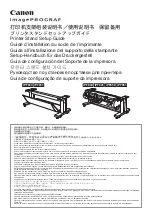
BUSY (out)
Compatible mode:
HIGH status indicates the printer is not ready to accept data.
Negotiation phase:
Reflects busy status in forward channel.
Reverse data transfer
phase:
Nibble data bit is 3, then 7 in nibble mode.
Reverse idle phase:
Reflects busy status in forward channel.
ECP mode:
Used for flow control in forward channel.
Also used in reverse mode as the 9th data bit, which indicates
whether signal data information is data or command.
PE
(out)
Compatible mode:
Indicates paper jam or paper empty status in paper tray or cassette.
ERRX goes LOW when PE goes HIGH.
Negotiation phase:
HIGH status indicates whether or not IEEE is supported.
Then, it follows nDataAvail (nFault).
Reverse data transfer
phase:
Nibble data bit is 2, then 6 in Nibble mode.
Reverse idle phase:
Remains HIGH until the host computer requests data transmission.
Then, it follows nDataAvail (nFault).
ECP mode:
Aknowledges nReverseRequest when this signal is set to LOW.
The host computer detects the status as an allowance to drive signal
data.
Slctout (out)
Compatibility mode:
Always HIGH
Negotiation phase:
Xflag indicates Extensibility flag. It is used in response to
extensibility request value from the host computer.
Reverse data transfer
phase:
Nibble data bit is 1, then 5 in nibble mode.
Reverse idle phase:
Same as negotiation phase.
ECP mode:
Same as negotiation phase.
AutoX (in)
Compatible mode:
Not used.
Negotiation phase:
This signal goes HIGH and IEEE 1284 active (nSelectIN) goes LOW
when requesting IEEE 1284 mode. Then it is set to HIGH by setting
PtrClk (nAck) to LOW.
Reverse data transfer
phase:
The host computer informs the printer that it is ready to receive data
in nibble mode by setting this signal to LOW. Then sets the signal to
HIGH to inform the printer that data has been received.
Reverse idle phase:
This signal goes HIGH in response to a LOW pulse of PtrClk (nAck)
to enter reverse data phase again. Reverse idle phase is returned to
compatibility mode if this signal goes HIGH and IEEE 1284 active
(nselectIn) goes LOW at the same time.
ECP mode:
Used for flow control of forward channel. Also used in reverse
mode as the 9th data bit, which indicates whether signal data
information is valid data or command.
Product Description
EPL-N2000 Service Manual
1-20
Rev. A
Summary of Contents for EPL-N2000
Page 1: ...EPSON TERMINAL PRINTER EPL N2000 SERVICE MANUAL EPSON 4006861 ...
Page 8: ...REVISION SHEET Revision Rev A Issued Date November 17 1996 Revision P a g e 1st issued ...
Page 131: ...Chapter 4 Adjustment No adjustment is required in this product ...
Page 133: ...Troubleshooting EPL N2000 Service Manual 5 2 Rev A ...
Page 167: ...A 2 Exploded Diagrams Figure A 2 Housing Appendix EPL N2000 Service Manual A 18 Rev A ...
Page 168: ...Figure A 3 Frames EPL N2000 Service Manual Appendix Rev A A 19 ...
Page 169: ...Fifure A 4 Paper Takeup Section 1 Appendix EPL N2000 Service Manual A 20 Rev A ...
Page 170: ...Figure A 5 Paper Takeup Section 2 EPL N2000 Service Manual Appendix Rev A A 21 ...
Page 171: ...Figure A 6 Drive Unit Appendix EPL N2000 Service Manual A 22 Rev A ...
Page 172: ...Fifure A 7 Transfer Unit EPL N2000 Service Manual Appendix Rev A A 23 ...
Page 173: ...Figure A 8 Fusing Unit Appendix EPL N2000 Service Manual A 24 Rev A ...
Page 174: ...Figure A 9 Paper Cassette Unit EPL N2000 Service Manual Appendix Rev A A 25 ...
Page 175: ...Figure A 10 Lower Paper Cassette Standard Appendix EPL N2000 Service Manual A 26 Rev A ...
Page 176: ...Figure A 11 Lower Paper Cassette Optional EPL N2000 Service Manual Appendix Rev A A 27 ...
Page 177: ...Figure A 12 Optional Duplex Unit Appendix EPL N2000 Service Manual A 28 Rev A ...
Page 188: ...EPSON ...
















































